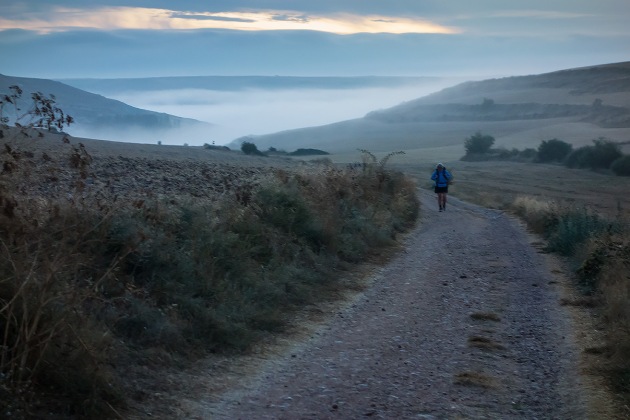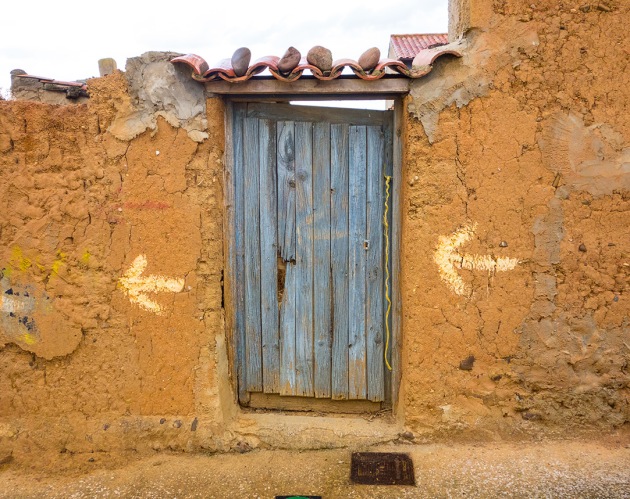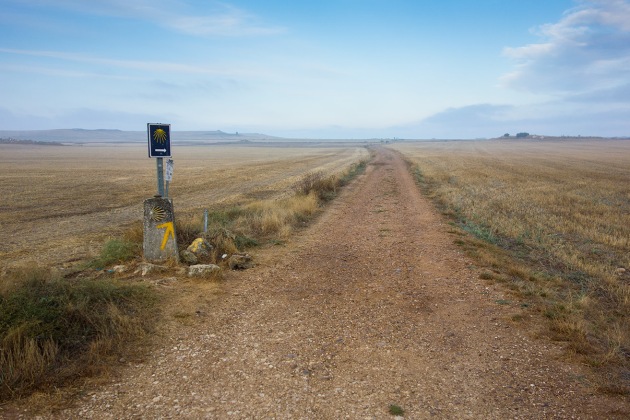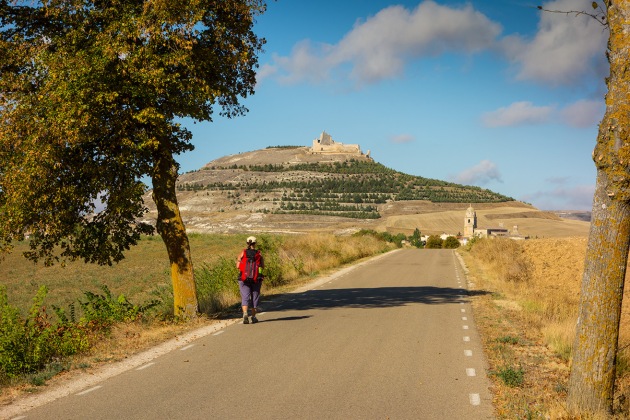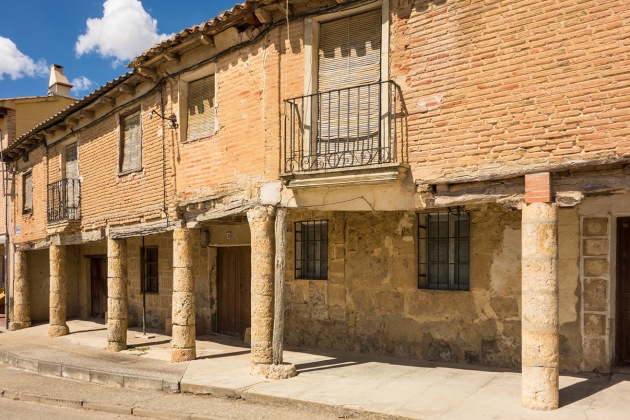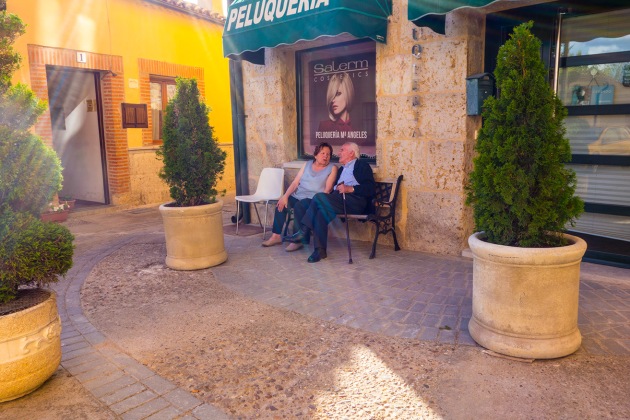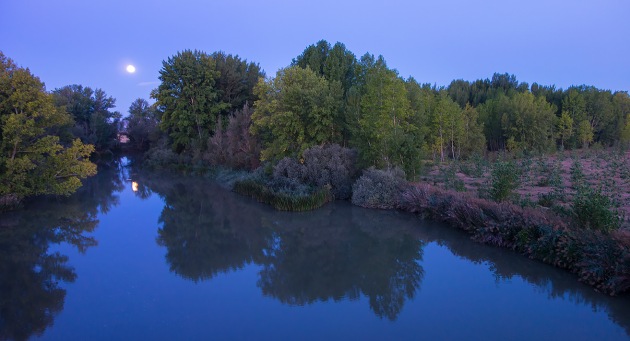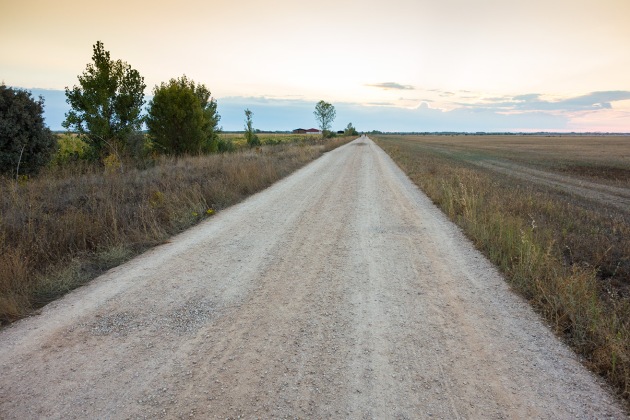In September 2013 I walked my first part of the Camino de Francés from Sarria to Santiago and I wrote about it here: https://carrigmanblog.wordpress.com/2013/09/28/camino-de-santiago-sarria-to-santiago. Like many others who have walked a section of the Camino, I returned to do another part of it and in September of this year I walked from Burgos to León, a 180 km trek across the Meseta.
This was a different landscape entirely to the Sarria to Santiago section which was through countryside very much reminiscent of parts of Ireland. The Meseta is open and mainly flat with wheat fields stretching as far as the eye can see. Some people hate it for its relative monotony and lack of variety. I loved it. I found the landscape to be quite beautiful and some of the towns and villages were far more picturesque than any I came across in Galicia.
I had timed my trip to coincide with a full moon – something I would recommend to anyone doing a week or two at a time – and it was a wonderful, numinous experience walking a few mornings in the still countryside bathed in bright moonlight a couple of hours before dawn. Even at those early hours there were other peregrinos (pilgrims) on the path. I even heard of people who walked only at night and slept by day- which is a bit extreme. However. doing at least one very early start – 5am or thereabouts – when there are clear skies is a must-do.
I have added a section below the photographs containing some practical advice for anyone thinking of doing the Camino either in whole or in part and information on what worked for me.
Here are some photographs that give an idea of what the route is like – click on them to see them in larger size:
The first day out from Burgos, the outskirts of the city have been left behind, and we are on the Camino proper.
The wheatfields are full of stubble now as the wheat has been harvested.
One of the iconic views of this section – downhill towards the village of Hornmillos del Camino. Roman legions would have passed this way.
The well dressed peregrino! Note the wide-brimmed Tilley hat to guard against the sun and the Buff neckband – a versatile piece of cloth that can be used as a headband, neckband, etc. Ideal for dunking in a water fountain and putting on one’s head to cool down. Brierley’s book of maps sticking out of the left Craghopper trouser pocket. The walking poles are not mine – they belonged to the photographer. I didn’t use walking poles but most walkers did. They’re probably more useful in more hilly terrain than the Meseta.
A panorama of typical countryside.
Just after dawn.
The ubiquitous yellow directional arrows mean that it is practically impossible to lose your way. The Camino is exceptionally well signposted.
Another of the yellow arrows as well as the scallop-shell sign pointing the way.
Occasionally the Camino intersects with a public road. The STOP signs are usually adorned with graffiti.
Approaching the village of Hontanas.
The last few kilometres into Castrojeriz is on a tarred road. Some small sections of the Camino are on such roads.
A picturesque row of houses in Castrojeriz.
An old door and window in a village street.
A couple of older folks having a chat.
The moon reflected in the Rio Pisuerga at Itero de la Vega.
The approach to Carrion de los Condes is by the side of a (not very busy) road.
This is part of the 17km stretch between Carrion de los Condes and Caldadilla de la Cueza – straight as a die as far as the eye can see. It was built by the Roman army – it’s part of the Via Trajana that connected France and Spain. I defy any man to walk this section and not imagine himself marching along in the uniform of a Roman legionnaire. It’s long and monotonous. It helps, if doing it on your own, to listen to some music to while away the time.
Some weary looking Sunflowers.
One of the doors to a Bodega – where wine is stored – at Moratinos.
This particular peregrino was carrying not only a substantial load on his back but he had a peculiar looking two-wheeled contraption in which he carried more stuff. He stepped into a harness between the two bars at the front and off he went, flat right tyre and all (he must have forgotton to pack a puncture repair kit). Most peculiar. He has done the Camino several times, he said, and he needed an extra challenge this time. He didn’t want his photo taken so I have used one that doesn’t reveal his face nor shall I name him. Without doubt, the most extraordinary walker I met. And he’s Irish!
Occasionally, you come across a memorial to a peregrino who died on the way.
Stormy skies. There was a thunderstorm between El Burgo Ranero and Mansilla de Las Mullas. Ear-splitting thunder and spectacular lightning. It was a marvelous experience walking along with flashes of lightning all around.
On the outskirts of León, the endpoint of my Camino this year.
The Cathedral of Santa Maria de León.
PRACTICAL ADVICE
FOOTWEAR: wear good quality walking shoes, not boots. Mine are Merrells:
Buy a pair one size larger than your normal shoe size. Be sure to have them “run in” at least a few months before you do the Camino. Otherwise, you will increase your chances of getting blisters, the bane of the peregrino. Which brings us to the subject of socks …
SOCKS – I brought “1000 Mile” socks which are “guaranteed to prevent blisters”. I must admit I was sceptical of this guarantee and had put it down to advertising hyperbole. My doubt was unjustified – the socks work: I hadn’t even a hint of a blister over the eight days I was walking and other walkers who had them reported the same happy outcome. They work because of their dual layer construction which eliminates friction between the foot and the shoe. It is this friction that causes blisters. The same result could probably be achieved by wearing two pairs of socks – a thin inner and a thicker outer. Bet that as it may, I am now a true believer in 1000 Mile socks – available at all good Outdoors stores and via Amazon – and will wear them for all long walking and hiking from now on. A further piece of advice that was given to me by a seasoned Camino walker whom I meet on the bus from Bilbao airport: don’t change your socks every day – wear them for three or four days at a time – and have a right sock and a left sock. I did so and it may or may not have contributed to my blister-free bliss. I wasn’t going to take any chances. (Not that I wore those socks all day – when I reached a day’s destination and showered, I changed into a clean pair. But I put back on the other socks when setting out the next morning.)
BACKPACK: buy a good quality one such as those made by Berghaus, North Face, etc. Get it in a dedicated Outdoors store where an assistant will be able to advise you regarding the best fit for you. A 30 to 35 litre bag is more than enough. Do *not* buy a cheap bag in a discount store. I met a man who did just that and he bitterly regretted it.
WHAT TO BRING: as little as possible. Reducing the weight of your backpack is of paramount importance. Mine weighed 7kgs but I met others who had it down to 5kgs. Here is what I had in my bag :
1. A spare Craghopper trousers (with removable lower legs to turn them into shorts)
2. A pair of lightweight shoes for relaxing in after the day’s walk was over.
3. Two Tilley briefs (they are quick drying and there are male and female ones)
4. Two pairs of 1000 Mile socks
5. Tilley hemp hat
6. A lightweight jacket for those cool mornings.
7. Three tee-shirts (could have got by with two)
8. iPod
9. Lightweight rain jacket (did not use)
10. Two-metre length of string and a few safety pins for drying clothes
11. Phone/camera charger and socket adapter
12. Spare 16GB memory card for camera.
13. Sony RX100 compact camera with 16GB memory card
14. Phone
15. Mini-tripod (pocketable) for camera.
16. Pilgrim Passport
17. Small cheap notebook and biro
18. John Brierley’s book of maps.
19. Razor, toothbrush, toothpaste, “King of Shaves” mini-bottle of shaving oil
20. Compeed blister plasters (did not use)
21. Factor 30 sun-screen
22.Boarding passes/passport/money/keys 23. Petzl head-torch 24. Six large (10 inches x 10 inches) zip-lock bags for storing some of the above items 25. Kindle 26. Two bottles of water.
Adopt the mantra: wash one, wear one. Live simply. As a woman said to me, the Camino is one place where no one gives a damn if you are wearing the same outfit for two days in a row. It’s not a fashion parade.
I DON’T WANT TO CARRY A HEAVY BAG – WHAT ARE MY OPTIONS? If you have used a travel agency to organise your trip it will probably have arranged to have your gear brought to your next destination each day. All you need to carry is a light day-pack. You can also avail of this service on your own – check out http://www.jacotrans.com/p/english.html. You will see leaflets advertising their service at most accommodations. It’s a handy service to fall back on if necessary.
WHERE TO STAY: here is where I confess to not being a real peregrino – I have never stayed in an albergue, the dormitory type of hostel accommodation where people sleep next to and over each other. It’s just that I am a very light sleeper and I fear that the nightly noises and comings and goings of my fellow pilgrims would interfere with my much needed sleep. I know I’m missing out on the communal spirit and bonhomie that the albergues engender and the loss is all mine, I’m sure. Still, I prefer my privacy and that’s that. So, I stay in hostals (not to be confused with hostels) which are like our B&Bs – you have a private room to yourself (and your partner, if relevant). They cost more – about €30 on average – as against €10 or so for an albergue but for me, for the short duration of my Camino, it is worth it. I get my sleep and I don’t have to worry about security (apparently, when taking a shower in an albergue you have to bring your passport, money and other valuables with you in a plastic bag). I also stayed in hotels when hostals were not available. Which brings me to how I booked them:
BOOKING ACCOMMODATION: I used Booking.com which I think is an excellent website. It also has a brilliant smartphone app which synchs perfectly with the website. Alternatively, you can just arrive in a town and check around for a room. At the very least you’ll end up in an albergue. Don’t worry – you won’t end up sleeping on a bench.
HOW FAR TO WALK EACH DAY? This is where you need one of John Brierley’s books. Brierley’s guides are excellent in that they provide a detailed map for each day’s walk and most walkers carry either his “Pilgrim’s Guide To The Camino de Santiago” or his “Camino de Santiago Maps”. (Available in good bookstores or from Amazon.) I prefer the latter. It is a reduced version of the former and contains the maps and a brief description of the walk. It has none of the spiritual waffle of the bigger book and it is much lighter to carry – always a major consideration. Here is an example of the walk from Carrión de los Condes to Terradillos de Templarios:
You don’t have to stop at Terradillos, of course. You can carry on to the next village, or further again, if you wish. However, Brierley has chosen a daily distance of 26.8kms for this stretch and daily distances of between 20 and 27kms are about right. Yes, you can attempt distances of more if you like but be careful – you can easily cause an injury to yourself by too much daily exertion. Relax after your walk. Chill out. Explore the village or town. Meet fellow walkers for a few drinks. Join them for a meal. That’s what the Camino is about, not trying to set some kind of distance record.
A TYPICAL DAY: Aim to get on the path at least a half an hour before sunrise. In September, this meant setting out at 7am at the latest. Check for the yellow arrows as you leave the town/village. You will see other walkers already on the trail. There will usually be a village a few kilometres away and you can stop there for breakfast if you haven’t already had one. Be sure you are carrying water, especially for those long stretches where there are no facilities. Drink plenty of water. After stopping for a coffee and something to eat, set off again. Keep a nice even comfortable pace. This is not a race. If you are walking with another person or persons and they are moving too fast for you, let them off. You can catch up with them at the next stop. Enjoy the sights, sounds and smells of the countryside. Talk to other walkers, maybe walk with them for a while. Take a rest when you feel the need. There is no rush. You will reach you destination for the day between 12 noon and 2 pm usually and if it takes longer, so what? There is plenty of time. Just be careful about the heat of the afternoon – it can be very intense.
When you book in to your accommodation – albergue, hostal or hotel – you can relax, have a shower, do your laundry and then head out and explore your surroundings and maybe have a drink with other walkers. Later, you can meet up for dinner, or stay on your own, or with your partner, whatever. You’ll probably go to bed around 9pm. The Camino is no place for late night carousing. You’d suffer too much the following day.
And that will be the daily routine, more or less, for however long you intend to walk.
IS IT SAFE? Absolutely. There is no question of any threat or menace attaching itself to any aspect of the Camino. For a woman walking on her own therefore there should be no concerns whatsoever. I passed several women solo walkers in the pre-dawn hours. There are always walkers ahead of you and behind you. So, if you were unfortunate enough to suffer an accident you can be sure that within minutes someone will come along to assist.
WHEN TO DO IT? You can do it at any time of the year but Spring and Autumn are the optimum times. Avoid June, July and August because of the intense heat.
WHY DO IT? A good question. People do the Camino for a variety of reasons. There are bona fide pilgrims who are doing it for traditional religious reasons; people who want the opportunity of a long distance walk to think about Life, The Universe, And Everything; individuals like André from South Africa whose wife died last year and he was doing it in her memory (with a picture of his wife on the back of his rucksack); others (like me) who enjoy the physical and mental challenge and who want to immerse themselves in an environment and in an activity totally different to The Real World back home. There is a very refreshing Zen like quality to the experience. The regular daily routine of putting one foot in front of another, wondering what is around the next corner or over the next hill, the concentration on getting to your destination – all contribute to pushing your normal everyday concerns back home into the background and enabling you to live, to some degree at least, in the Now. You will invariably return not only in better physical shape but mentally as well. And perhaps, as Bernard from Galway said to me, “you have to be a little bit mad to do it”.
There is also the fact that you are taking part in something that stretches back to the 12th century, that the path you are treading has been walked on by hundreds of thousands, probably millions, of people before you and pilgrims will continue to pass this way long after you are gone. This sense of participation in a great and ancient enterprise is both humbling and empowering. It provides purpose and meaning to what in one sense is just a long walk but ultimately is so much more than that. It is remarkable that what grew out of a medieval religious worldview, a perspective that is alien both to the modern religious as well as secular mindset, should be growing in popularity every year. The desire for pilgrimage – a journey of spiritual significance regardless of how one interprets “spiritual”, be it the traditional believer’s journey for a saint’s blessing, or the modern man’s quest for mindfulness or whatever- seems to be a powerful one and the Camino satisfies that need regardless of one’s religious or non-religious affiliation.
HOW TO ORGANISE THE TRAVEL ARRANGEMENTS: There are travel companies that will do all the arrangements for you but it is cheaper and easy to do it yourself. I flew from Dublin to Bilbao with Aer Lingus. If you are starting in St Jean Pied de Port fly Ryanair to Biarritz. If doing the Sarria to Santiago section fly Aer Lingus to Santiago. You can also fly to Madrid and get a train from there. There are many options depending on which section of the Camino you want to do. For rail timetables check out http://www.renfe.com and for buses, http://www.alsa.es. (You can get great online fares – my 5-hour train journey from León to Bilbao cost €12.50!) As ever, Google is you friend. I started planning my trip in May so give yourself plenty of time.
I hope this has been of some help. Please contact me if you have any questions.






